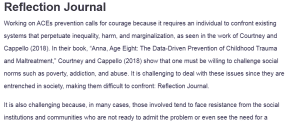Reflection Journal
Working on ACEs prevention calls for courage because it requires an individual to confront existing systems that perpetuate inequality, harm, and marginalization, as seen in the work of Courtney and Cappello (2018). In their book, “Anna, Age Eight: The Data-Driven Prevention of Childhood Trauma and Maltreatment,” Courtney and Cappello (2018) show that one must be willing to challenge social norms such as poverty, addiction, and abuse. It is challenging to deal with these issues since they are entrenched in society, making them difficult to confront: Reflection Journal.
It is also challenging because, in many cases, those involved tend to face resistance from the social institutions and communities who are not ready to admit the problem or even see the need for a solution to these challenges. Courtney and Cappello (2018) state that community leaders and individuals who are ready to face these challenges and remain robust should know that their work is important in creating a healthier society.
Other large social problems that call for courage in their resolution include the segregation of people with HIV/AIDS, pushing for civil rights for many minority groups, and addressing global challenges like the climate crisis (Tarshish et al., 2024). One can draw examples from people like Martin Luther King Jr., who faced violence and imprisonment to achieve racial equality. To fight for these rights and ensure justice, equality, and fairness, one must be ready to face resistance and sometimes confrontation from supporters of dysfunctional societal norms.
One problem in society that has been solved and can be used as a model for addressing ACEs is the significant reduction of smoking. Notably, it is important to use data and evidence-based strategies to deal with social issues (Courtney & Cappello, 2018). This approach aligns with the approach taken by stakeholders to minimize smoking.
Anti-smoking campaigns combined policy changes, media advocacy, public health education, and, most importantly, banning (Tarshish et al., 2024). These worked effectively to change perceptions, attitudes, and people’s tendencies toward smoking. These efforts show that multi-pronged approaches are needed when addressing ACEs.
My role in ending the pandemic of childhood trauma and maltreatment is advocacy. I intend to advocate for trauma-informed practices and promote awareness about ACEs within the community. Courtney and Cappello (2018) outline several actionable strategies, which I believe can motivate me to do better in my advocacy role.
My contribution is raising awareness, supporting efforts to build resilient communities, and encouraging leaders to adopt data-driven prevention methods (Tarshish et al., 2024). I believe that if I work collaboratively with other stakeholders, I will be able to create an accommodative environment and a trauma-free atmosphere for children to thrive.
References
Courtney, K. O., & Cappello, D. (2018). Anna, age eight: The data-driven prevention of childhood trauma and maltreatment. CreateSpace Publishing.
Tarshish, N., David, P., & Krumer-Nevo, M. (2024). Social work advocacy: Towards a trauma-informed model. Clinical Social Work Journal. https://doi.org/10.1007/s10615-024-00942-1
ORDER A PLAGIARISM-FREE PAPER HERE
We’ll write everything from scratch
Question 
Textbook link: : Anna, Age Eight The data-driven prevention of childhood trauma and maltreatment
Take a moment and look back on the material we have reviewed this term, in relation to your field placement and the social work practice you have witnessed as well as conducted. Respond to the four questions below in a word submission. This writing is informal, personal, and does not require citation or academic tone – beyond general professional presentation absent grammar and spelling error.
- Why would it take courage to work on ACEs prevention?
- What other large social problems required courage and risk to solve?
- What is one social problem you see as solved that can serve as a model for addressing ACEs?
- What is your role in ending the epidemic of childhood trauma and maltreatment?

Reflection Journal
Take your time, although this seems an informal submission, it is an assessment of your comprehension of the Anna, Age Eight text. Reflect it’s importance, regardless of academic citation and use of first person language.
- Field placement is IHSS: In home supportive services.
- Also take a look at order: #57905-CQI-A1: Assessment, order #58324- Planning Phase, and order # #58699-Action Phase &.#58871.